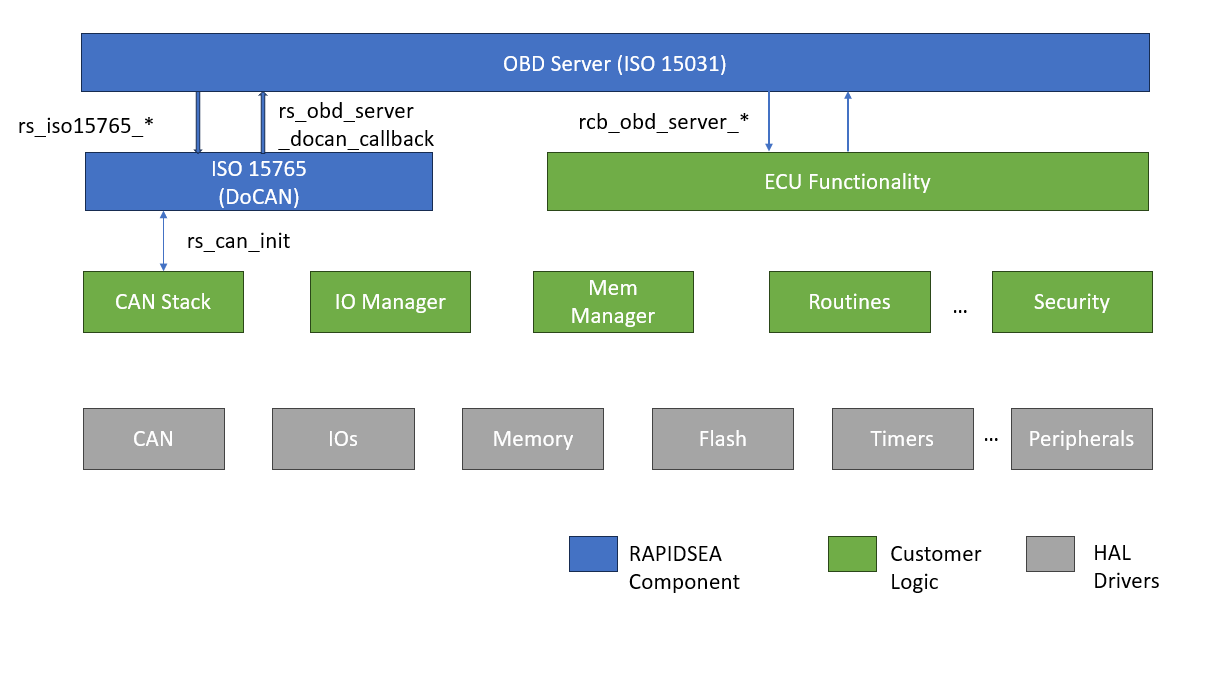OBD-II Server Stack
Overview
RAPIDSEA supports ISO15031 protocol as explained in the ISO15031 - OBD Protocol page. This page explains the server architecture and details how the user should interface the stack with their custom logic and realize the ECU implementation quickly. It also provides guidelines on adopting the stack for different systems.
The below diagram captures the block level diagram of the DoCAN OBD server and how it interfaces with other modules.

DoCAN Interface
The OBD server communicates over the CAN network through the underlying DoCAN stack (ISO15765). This DoCAN stack is also available as part of the RAPIDSEA components. All the functions that are needed are available as part of the DoCAN stack and has to be compiled together.
Mode |
Description |
|---|---|
rs_iso15765_* |
Set of functions called by OBD server to perform operation such as initialize, transmit messages etc |
rs_obd_server_docan_callback |
Callback function called by the DoCAN layer to inform of Data Indication, error etc |
These details with respect to the DoCAN interface are covered in detail in the ISO15765 - DoCAN Protocol page.
Application Interface
While the RAPIDSEA OBD server stack can handle most of the functionality such as message validation, session management, timing control etc, the business logic has to implement the application functionality. the RAPIDSEA OBD server clearly defines API and callback functions that are essential for the user to use/implement.
The below table captures the function that are to be called from the application logic.
Function |
Description |
|---|---|
rs_obd_server_open |
To initialize the OBD server stack |
rs_obd_server_set_p2_timing |
To setup the P2 timing associated with the server |
rs_obd_server_process |
To be called periodically to process the incoming/outgoing messages |
There are many functions through which the OBD server stack retrieves information from the application logic or indicate actions to be performed. These functions are captured in the below table.
Function |
Description |
|---|---|
rcb_obd_server_01h_req_current_diag_data |
Called to indicate request Current Diagnostic Data |
rcb_obd_server_02h_request_freeze_frame_data |
Called to indicate request Freeze Frame Data |
rcb_obd_server_03h_req_diag_trouble_code |
Called to indicate request Diagnostic Trouble Codes |
rcb_obd_server_04h_clear_dtc |
Called to Clear/Reset Diagnostic Trouble Codes and information |
rcb_obd_server_05h_req_oxygen_sensor_monitoring |
Called to indicate request Oxygen Sensor Monitoring Test Results |
rcb_obd_server_06h_req_on_board_monitoring |
Called to indicate request On-Board Monitoring Test Results for Specific Monitored Systems |
rcb_obd_server_07h_req_emission_diag_trouble_code |
Called to indicate request Emission-Related Diagnostic Trouble Codes Detected During Current or Last Completed Driving Cycle |
rcb_obd_server_08h_req_ctrl_of_on_board_system |
Called to indicate request Control of On-Board System, Test or Component |
rcb_obd_server_09h_req_vehicle_information |
Called to indicate request vehicle information |
These functions are documented in detail in the below sections. It is important for the server to implement these functions correct for proper operation of the system.
Implementation Guide
This section explains how the OBD server can be implemented using the RAPIDSEA stack. Whether the stack is available in source form or in binary form, the steps to be followed are
Implement the Callback functions mentioned above
Implement the underlying rs_can_* functions for DoCAN as per the underlying hardware design as described in the CAN Interface page.
Initialize the buffers necessary for the operation
Initialize the CAN, ISO15765 and ISO15031 stack function for DoCAN.
Periodically call the process functions so that internal timeouts are handled.
High level flow chart is depicted below for DoCAN:

This can be implemented in a bare-metal system or over RTOS or over full fledged OS such as Linux etc.
Dependency
This stack depends on the below RAPIDSEA interfaces that can be obtained or custom implemented.
Example demo
An example implementation is available along with the release and is described in DoCAN OBD-II Server Demo.
OBD Header Details
Documentation from the relevant header as follows:
Warning
doxygenfile: Cannot find file “rs_obd_server.h